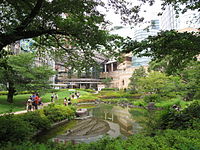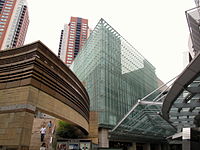Roppongi Hills(Roppongi ヒルズ,Roppongi Hiruzu)is adevelopment project in Tokyoand one of Japan's largestintegrated property developments,located in theRoppongidistrict ofMinato,Tokyo.
| Roppongi Hills | |
|---|---|
 Roppongi Hills, with theMori Tower(right) and the Residences B and C (left) | |
 | |
| General information | |
| Location | Minato, Tokyo,Japan |
| Coordinates | 35°39′36″N139°43′48″E/ 35.66000°N 139.73000°E |
| Construction started | 2000 |
| Completed | 2003 |
| Opening | April 25, 2003 |
| Owner | Mori Building |
| Height | |
| Roof | Mori Tower:238.1 m (781 ft)[1] Residences B and C: 159.1 m (522 ft)[1] GrandHyattTokyo: 95.7 m (314 ft)[1] |
| Technical details | |
| Floor count | Mori Tower: 54 Residences B and C: 43 Grand Hyatt Tokyo: 21 |
| Floor area | Total: 724,000 m2(7,790,000 sq ft)[2] |
| Design and construction | |
| Architect(s) | Kohn Pedersen Fox |




Constructed by building tycoonMinoru Mori,the mega-complex incorporates office space, apartments, shops, restaurants, cafes, movie theatres, a museum, a hotel, a major TV studio, an outdoor amphitheatre, and a few parks. The centrepiece of the complex is the 54-storyRoppongi Hills Mori Tower.Mori's stated vision was to build an integrated development where high-rise inner-urban communities allow people to live, work, play, and shop in proximity to eliminate commuting time. The company argued that this would increase leisure time, quality of life, and benefit Japan's national competitiveness. 17 years after the design's initial conception, the complex opened to the public on April 25, 2003. The architecture and use of space is documented in the bookSix Strata: Roppongi Hills Redefined.[3]
Development
editRoppongi Hills cost over $4 billion and was built on a 27-acre (109,000 m2) site. The site amalgamated more than 400 smaller lots Mori acquired over 14 years.[4][5]
Mori Tower
editMori Toweris a 54-storyhigh-risebuilding designed byKohn Pedersen Foxthat houses an art museum, restaurants, cafes, clinics, stores, as well as the offices ofAllen & Overy,Barclays Capital,Ferrari Japan,Goldman Sachs,J-WAVE,Konami,Time Inc.,Chevron,BASF,Lenovo,Mercari,Baidu,GREE,BP,SAS InstituteandGoogle.The Pokémon Companyalso has its headquarters in the Mori Tower.[6] The first six levels of Mori Tower contain retail stores and restaurants. The top six floors house theMori Art Museum[7]and the Tokyo City View with panoramic views of the city. A new exit fromRoppongi Stationempties into a glass atrium filled with large television screens and escalators, as well as several shops and restaurants. The rest of the building is office space.
Other buildings
editAround the Mori Tower are several smaller buildings predominantly occupied by shops and restaurants, a cinema complex and the Mori Garden. Behind the Mori Tower lies the Keyakizaka Street, famous for its night illumination of 1.2 million shining LEDs that begin in mid-November and run until Christmas Day.[8][9]Keyakizaka also features cafes and luxury stores such asLouis Vuitton.[10]Nearby are the four Roppongi Hills residence towers, with a total of 793 residential apartments.[11]
Large open spaces have been built into the design of Roppongi Hills. About half of the area consists of gardens, pavilions, and other open spaces. The Mori Garden, an elaborate and authentic Japanese garden complete with a pond and trees is particularly popular. The garden is part of a lost mansion that housed members of the feudalMōri clan.[12][13]
On Roppongi Hills the exhibition of theUnited Buddy Bearswas shown in 2005 for the first time in Japan. The exhibition was opened by the President of the Federal Republic of Germany,Horst Köhler,together with the Prime Minister of Japan,Junichiro Koizumi.According to the Mori-Group, project partners in Tokyo, they were able to count three million visitors over the six weeks of the exhibition.[14]
TheAmerican School in Japan's Early Learning Center is housed in a residence building next to the Hills, the Roppongi Sakura-zaka Residence.[15]A playground adjacent to the complex, near the school, is known in English as Robot Park and has robot-themed play equipment.
TheheadquartersofTV Asahiis also situated in Roppongi Hills, next to the Mori Garden. The building was designed by architectFumihiko Maki.[16]
Criticism
editRoppongi Hills Arena is a facility with large outdoor speakers, in proximity to older housing. Since the construction of the Roppongi Hills development, complaints of noise pollution from older residents have been ignored by Mori Building management, according to residents. The building most directly suffering from noise is on top of an embankment opposite the Arena. Residents say several residents have been forced out by the noise.[17][18]
Henry Hilton of theJapan Todaynews aggregator website criticised the development when he argued:
Yet the truth is that the crowds are unlikely to return once they have been exhausted by the charade of inconvenient walkways that appear almost intentionally to confuse all but those with perfect map navigational skills. The whole maze is far from being user friendly—don't count on full protection from autumn showers or sudden gusts of wind generated by the buildings themselves.[19]
Financial issues
editMori Building has financed the project with $800 million equity and $1.3 billion in debt from a syndicate of banks led by the Development Bank of Japan. As a result, the company's overall debts are $5.6 billion, secured by billions more in assets.
Goldman Sachs& Co., the project's anchor tenant, attracted deep discounts in rental prices because of the large amount of space it occupies. Japan's sluggish economy, staff cuts by foreign companies, and the flow of new office space have put downward pressure on rents.
Because ofeminent domainlaw in Japan, several past residents of the site that would be Roppongi Hills have been given residential units in the complex in return for their agreement to vacate their prior homes, so that their prior homes would be demolished and the land used for the development of Roppongi Hills.
See also
edit- Omotesando Hills,a similar (but smaller) development also built by Mori
- Jerde-associated architectural projects in Japan:
References
edit- ^abc"Roppongi Hills".The Skyscraper Center.Council on Tall Buildings and Urban Habitat.Archivedfrom the original on 23 October 2022.Retrieved8 April2023.
- ^"Jerde PlaceMaking".Jerde. 2011-10-10.Archivedfrom the original on 2016-06-16.Retrieved2013-08-11.
- ^ Homma, Takashi (2006).Six Strata: Roppongi Hills Redefined.London: Heibonsha.ISBN4582277594.
- ^Bremner, Brian. "Rethinking Tokyo."BusinessWeek.November 4, 2002. Retrieved on May 11, 2009.
- ^Brasor, Philip, and Tsubuku, Masako. "Roppongi Hills: controversial blueprint for Tokyo's new breed of high-riseArchived2016-12-18 at theWayback Machine."The Guardian.May 18, 2015.
- ^"Hội xã điểm chínhArchived2010-09-14 at theWayback Machine."The Pokémon Company.Retrieved on October 5, 2009.
- ^"Roppongi Hills".destination360.Archivedfrom the original on 1 July 2022.Retrieved8 April2023.
- ^"Illumination at Keyakizaka-dori Street Roppongi Hills".WAttention.4 June 2020.Archivedfrom the original on 1 October 2022.Retrieved8 April2023.
- ^"Keyakizaka Illumination".Time Out.Archivedfrom the original on 10 November 2022.Retrieved8 April2023.
- ^"Louis Vuitton".Roppongi Hills.Archivedfrom the original on 8 April 2023.Retrieved8 April2023.
- ^"Roppongi Hiruzu Rezidensu A-tō no tokuchō"[Features of Building A, Roppongi Hills Residence] (in Japanese). Archived fromthe originalon 21 October 2017.Retrieved21 October2017.
- ^"Mori Garden Roppongi Cherry Blossoms".Japan Web Magazine.8 March 2017.Archivedfrom the original on 29 September 2022.Retrieved8 April2023.
- ^"Serviced apartments in Japan—Taking quality of life to new heights: Garden".Mori Living.Archived fromthe originalon December 9, 2004.Retrieved21 October2017.
- ^"top page, Consulate-General of the Federal Republic of Germany in Osaka-Kobe"ドイツ đại sứ quán ドイツ tổng lãnh sự quán - トップページ(in Japanese). Osaka-kobe.diplo.de. 2013-07-09.Archivedfrom the original on 2012-02-27.Retrieved2013-08-11.
- ^"Roppongi Sakura-zaka Residence | Residence Information | Residences for Lease | MORI LIVING | Mori Building Co., Ltd".Mori Living.Archivedfrom the original on 2012-03-27.Retrieved2013-08-11.
- ^"Kiến trúc gia とデザイン".Roppongi Hills.Archivedfrom the original on 2020-09-26.Retrieved2023-03-26.
- ^"The Japan Times Online".japantimes.co.jp.Archived fromthe originalon 11 December 2003.Retrieved17 January2022.
- ^[1]ArchivedOctober 14, 2004, at theWayback Machine
- ^"File Not Found".Archived fromthe originalon 2007-10-16.Retrieved2016-02-08.
External links
edit- Official website(in Japanese)